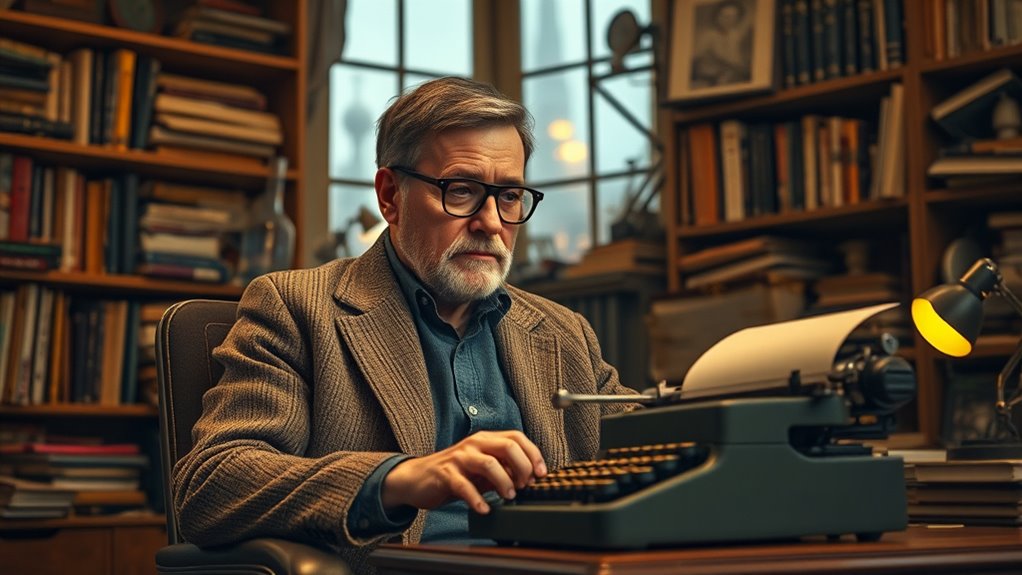Robert A. Heinlein suggests that weapons are inherently neutral tools, and their danger depends entirely on how humans choose to use them. The moral impact isn’t in the weapon itself, but in the ethical decisions behind its development and employment. Technological advances increase power, but it’s human responsibility that determines whether weapons bring harm or peace. If you want to understand how morality shapes technology and its dangers, keep exploring Heinlein’s perspective further.
Key Takeaways
- Heinlein argues that weapons are inherently neutral; their danger depends on human intent and use.
- Ethical context, not the weapon itself, determines whether it promotes peace or conflict.
- Technological progress can be managed responsibly to serve positive purposes like defense and communication.
- Human agency and moral responsibility are central; tools require human decision to be dangerous or safe.
- Recognizing weapons’ neutrality encourages responsible stewardship and prevents fear from technological advancements.

Many people believe that weapons are inherently dangerous, but Robert A. Heinlein challenges that notion by suggesting that the danger lies not in the weapon itself but in how humans choose to use it. When you consider the role of ethical considerations, it becomes clear that technology alone doesn’t determine whether a weapon is good or evil. Instead, your values and decisions shape its impact. Heinlein emphasizes that technological advancements have made weapons more powerful and accessible, but these innovations don’t inherently carry moral weight. It’s your responsibility to decide whether to wield such tools for destruction or for protection.
Heinlein’s perspective encourages you to look beyond the surface of technological progress. You might see a new missile or a laser weapon and think of its destructive potential, but he urges you to ask: What are the ethical considerations behind its development? Are you creating it to defend, to deter, or to dominate? The moral context you provide influences whether the weapon becomes a tool for peace or conflict. Heinlein suggests that weapons, in and of themselves, are neutral; it’s your intent and purpose that determine their danger or safety.
Furthermore, Heinlein’s view pushes you to recognize that technological advancements can be harnessed for good. Instead of fearing new innovations, you’re encouraged to understand their potential for positive change. For example, advancements in communication technology can be used to foster understanding and collaboration rather than conflict. The same applies to weaponry: if you prioritize ethical considerations, you can develop and control weapons that serve a defensive or deterrent role, rather than escalating violence. This mindset shifts the focus from condemning technology to managing it responsibly.
Heinlein’s core message is empowering. He wants you to realize that you hold the moral agency in how weapons are used. The tools are not inherently dangerous—your choices are. As technological advancements continue to evolve, your ethical considerations become even more critical. It’s up to you to ensure that progress doesn’t lead to destruction but instead fosters safety, stability, and peace. By understanding that weapons are morally neutral and that their impact depends on human intent, you regain control over how technology shapes your future. Heinlein’s philosophy reminds you that nothing is inherently dangerous; it’s the human element that truly determines whether a weapon becomes a threat or a safe tool. Recognizing moral neutrality allows you to focus on responsible stewardship rather than fear.
Frequently Asked Questions
What Inspired Heinlein’s Philosophy on Non-Violent Conflict Resolution?
Your curiosity about Heinlein’s philosophy on non-violent conflict resolution stems from his diverse literary influences and the origins of his philosophy. He was inspired by ethical ideas and science fiction themes emphasizing individual responsibility and peaceful solutions. Heinlein believed that understanding human nature and promoting rational dialogue could resolve conflicts more effectively than violence. His works reflect these principles, encouraging readers to seek non-violent ways to address disputes.
How Did Heinlein’s Views Influence Modern Peace Movements?
You see Heinlein’s views shaping modern peace movements through the principles of ethical diplomacy and peaceful innovation. His belief that true power lies in knowledge and moral strength inspires advocates to prioritize dialogue over violence. By emphasizing nonviolent conflict resolution, Heinlein’s philosophy encourages today’s movements to foster understanding, promote diplomacy, and explore innovative peaceful solutions, ultimately transforming how societies approach peace and conflict in a more constructive, compassionate way.
Are There Real-World Examples of Non-Weaponized Conflict Solutions?
Yes, there are real-world examples of non-weaponized conflict solutions. You can observe diplomatic negotiations that resolve international disputes peacefully, like treaties and peace talks. Community mediation also plays a vital role in resolving local conflicts, helping parties find common ground without violence. These methods emphasize dialogue, understanding, and cooperation, proving that conflicts can often be settled through communication rather than weapons, aligning with the idea that no weapon is inherently dangerous.
What Was Heinlein’s Background That Shaped His Beliefs?
Heinlein’s beliefs were shaped by his personal upbringing and military experience. Growing up in a disciplined household, he learned the importance of responsibility and self-reliance. His time in the Navy exposed him to the realities of conflict and the value of strategic thinking. These experiences led him to believe that weapons themselves aren’t inherently dangerous; rather, it’s how people use them that determines their impact.
How Do Heinlein’s Ideas Compare to Contemporary Disarmament Efforts?
You see Heinlein’s ideas clash with today’s disarmament efforts; he believes technology itself isn’t dangerous, but our moral philosophy determines its impact. While contemporary debates focus on technological ethics, emphasizing restrictions, Heinlein urges responsibility and ethical use. Imagine wielding powerful tools with moral clarity, rather than fearing the tools themselves—this juxtaposition highlights that safety depends on human character, not just regulations.
Conclusion
Remember, you hold the power, not the weapon. Just as a pen can create worlds or destroy lives, weapons themselves are neutral—it’s how you choose to use them that matters. Don’t be fooled into fearing the tool; instead, focus on your intent and responsibility. In the end, it’s your mind and morals that determine whether a weapon becomes a source of danger or a force for good. The true danger lies within you, not the weapon.
Joy, as our Editor in Chief, ensures the highest standard of content. Her talent in writing is complemented by her attention to detail and passion for literature and culture. Joy’s expertise and love for the English language shine through in her editorial work, making each piece a testament to quality and clarity.










